History Of The Ford F100: An Illustrated Guide
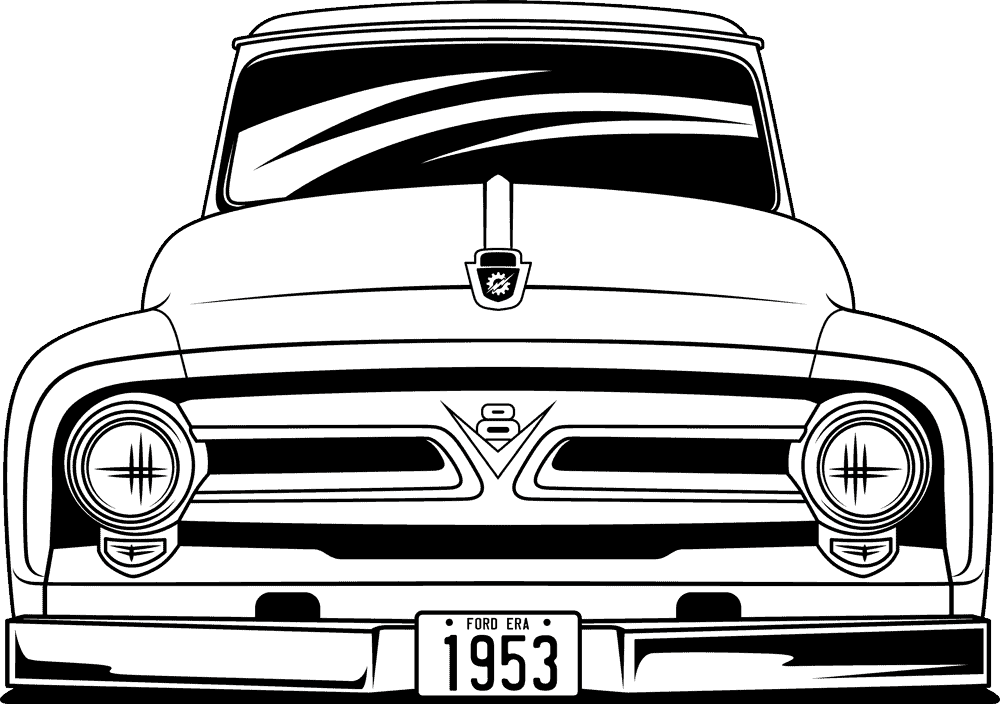
For 50 years, Ford trucks were known as the F-series, or F1 for short. To celebrate their 50th anniversary in 1953, they changed this designation to the F100.
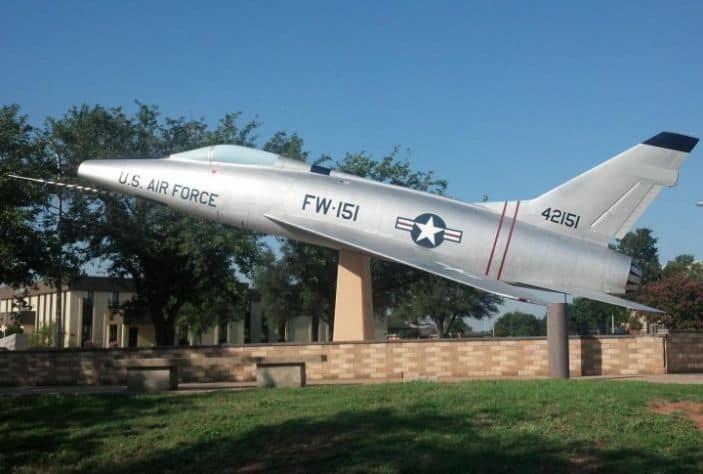
This change was partially influenced by the North American F100 Super Sabre jet fighter. Ford then built the F100 models for 30 more years before changing to the current F150.
What were the generations of F100 Ford trucks?
- 2nd generation 1953 to 1956
- 3rd generation 1957 to 1960
- 4th generation 1961 to 1966
- 5th generation 1967 to 1972
- 6th generation 1973 to 1979
- 7th generation 1980 to 1986 (F100 only thru 1983)
It All Started With The F1: First Generation
In 1948 Ford introduced a completely new post-war era truck called the F-series. This new series was known as the “Ford Bonus Built” truck. The Ford F1 was immediately very popular with the truck buying public, as it sold 108,000 units in its first year.
With fears that the Korean war would lead to similar manufacturing restrictions as World War II had, sales for the 1950 F1 tripled from the 108,000 sold in 1948. These worries of production cuts came true as quotas restricted Ford’s production numbers significantly in 1952.

Very few changes were made in the truck from 1948 to 1950. In 1951 they made some grille changes with more protruding headlights and three large evenly spaced supports.
During the 1952 model year, truck sales were declining. So Ford began working on the redesign of its F1 1/2-ton pickup. The body of the F1 remained the same for the remainder of the 1952 model year as they prepared for the all new 1953 F100 series to be introduced.
The 1948 F series colors available from the factory were:
- Vermillion
- Arabian Green
- Chrome Yellow
- Birch Gray
- Black
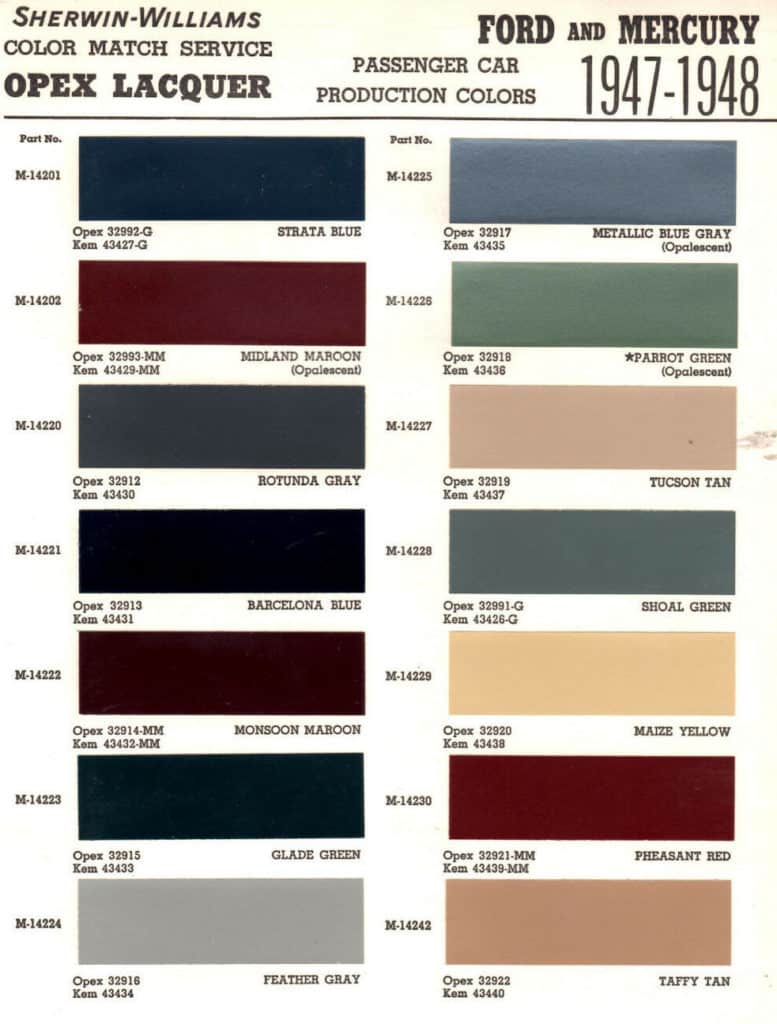
2nd Generation 1953 to 1956: The First F-100 Models
With the introduction of the second generation of Ford’s F-Series light-duty trucks, the F100, Ford didn’t realize until many years later that they had created one of the most popular trucks ever– the ones rebuilders and truck enthusiasts would immediately think of when they talk about classic trucks.
Ford referred to these new models as the “Economy Truck Line” instead of the previous line from 1948 to 1952 that were called the “Bonus Built” models.
This first year of the 1953 F1 offered optional interior amenities including sun visors, dome lights, lighters, armrests, and a radio. The Ford-O-Matic automatic transmission became an option on March 13, 1953.

The new 239 cubic inch overhead valve Y-block V8 replaced the flathead engine that was retired in 1954 in the United States. The new engine was called the “Power King”. The six cylinder was enlarged from 215 cubic inches to 233 cubic inches, and as an option you could also get power steering. In the following years, the 256 cubic inch V8, 272 cubic inch V8, and the 312 cubic inch V8 replaced the 239 Y -block.
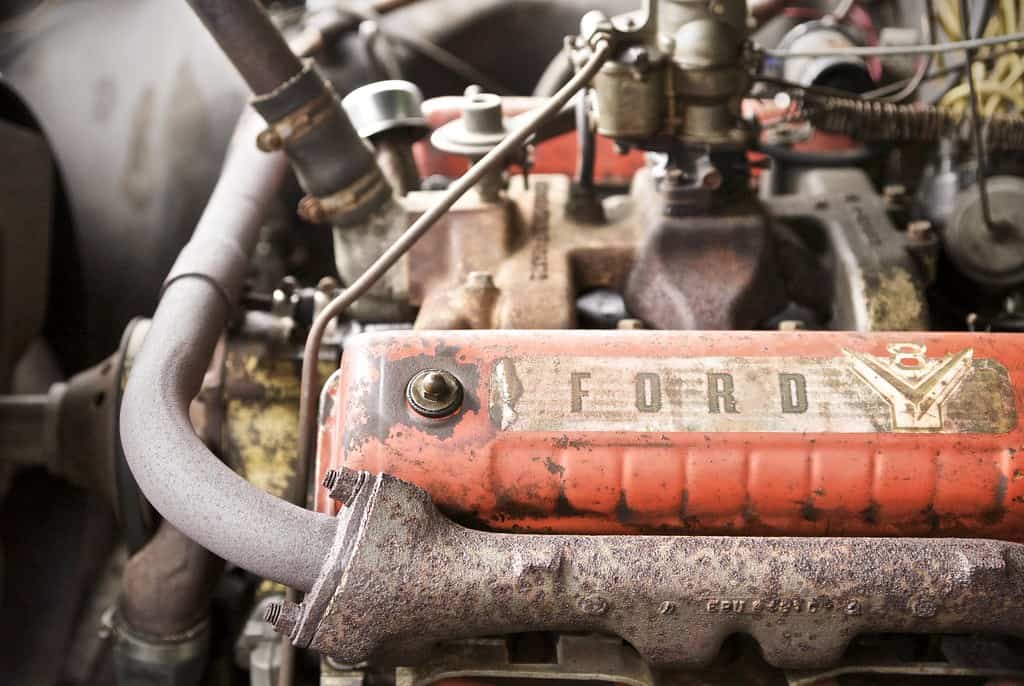
The 1956 F-100 was a one-year only body style and is easily identified by the vertical windshield pillars and the wrap around windshield. The 1956 model year also had the option of a larger wraparound back window which makes it a very desirable option among collectors and rebuilders. 1956 is also the year that Ford offered the very rare “Low GVWR” versions of each model and the first year that seat belts became an option.
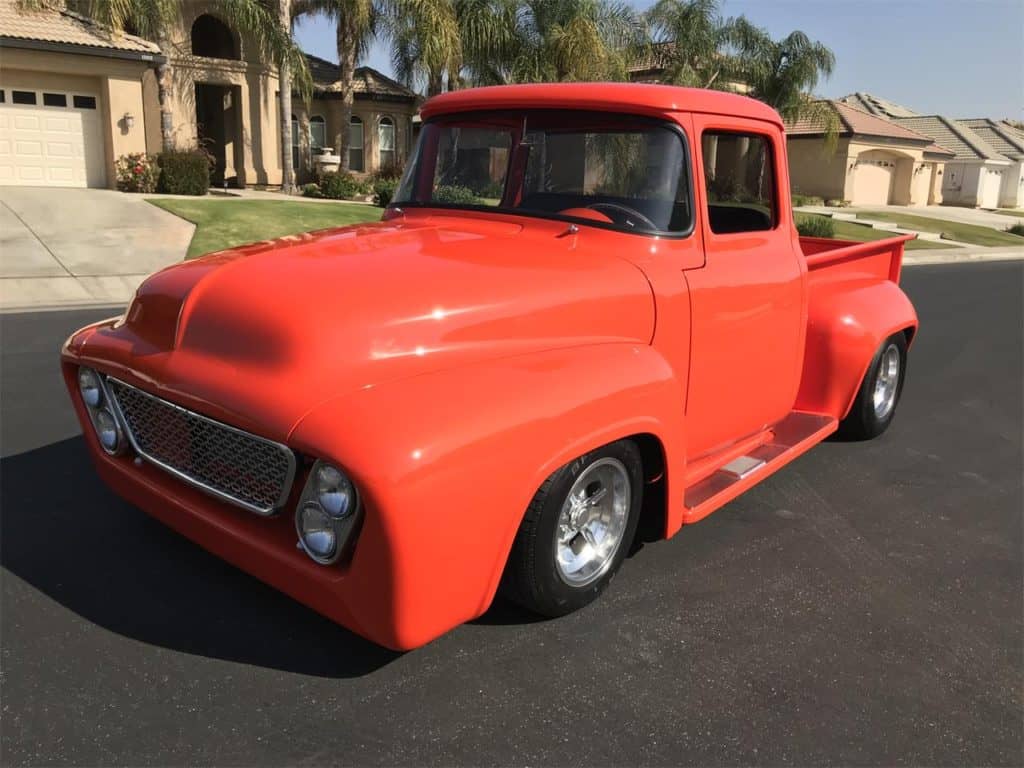
Production of the 1953 Ford F-100 Pickup: 116,437
Production of the 1954 Ford F-100 Pickup: 101,202
Production of the 1955 Ford F-100 Pickup: 124,842
Production of the 1956 Ford F-100 Pickup: Short bed: 137,581 Long bed: 25,122
The color choices from the factory in 1956 were:
- Raven Black
- Dark Blue Metallic
- Light Blue
- White (for two-tone)
- Light Green
- Torch Red
- Meadow Green
- Yellow
- Gray
- Prime
| Engine | Years | Horsepower |
| 215 CID Straight 6 | 1953 | 101 |
| 239 CID Flathead V8 | 1953 | 100 |
| 223 CID Milage Maker Inline 6 | 1954-1955 | 115 |
| 239 CID Y-block V8 | 1954-1955 | 130 |
| 223 CID Milage Maker Inline 6 | 1956 | 137 |
| 256- CID Y-block V8 | 1955 | 140 |
| 272- CID Truck 2V Y-block V8 | 1956 | 172 |
| 279- CID Lincoln Y-block V8 | 1954-1956 | 152 |
| 312- CID Lincoln Y-block V8 | 1954-1956 | 170 |
| 368- CID Lincoln Y-Block V8 | 1956 | 300 |
| Transmissions | Automatic | Standard |
| Heavy Duty 3 Speed | ||
| 4 Speed Manual | ||
| 3 Speed | ||
| Ford-O-Matic |
Specifications of the 1953-1956 Ford F-100 Pickup:
Wheelbase, inches: 110.0 – 118.0
Length, inches: 189.1 – 203.2
Weight, pounds: 3,102 – 3,325
Price, new: $1,330 – $1,611 (U.S.)
3rd Generation: 1957 to 1960
Ford followed its competitors at General Motors and Dodge Motor Company and widened the front of the body that integrated the front fenders and cab together. Ford even went further than their competition by also integrating the hood into the bodywork. This clamshell design feature would stay with Ford for 20 years. The chrome grille was also more prominent than it had been previously.
This 3rd generation F100 offered two types of pickup boxes naming the separate-fender box the “Flareside“, while the “Styleside” made the pickup bed, cab and fenders integrated. A low GVWR (gross vehicle weight rating) of each model was still offered.
For the model year of 1958, quad headlights replaced dual headlights and Ford became the first of the big three manufacturers to build their four wheel drive trucks on their own. Previously they had outsourced all four wheel drive manufacturing to Marmon-Herrington.
For the year 1959 more buyers still purchased the 6-1/2 foot bed over the 8 foot bed, even as the longer bed gained in popularity and soon would outsell the shorter bed. Also the popular Flareside bed would be outsold by the smooth-sided Styleside.
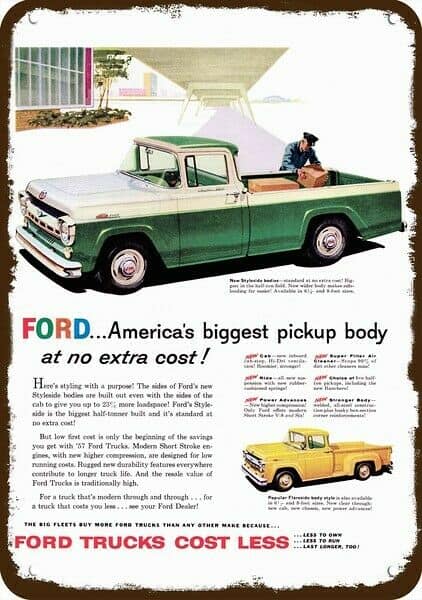
Ford kept the same body for 1960 with the grille being extended down to the bumper and had slots added in the hood where the grille would extend up to.
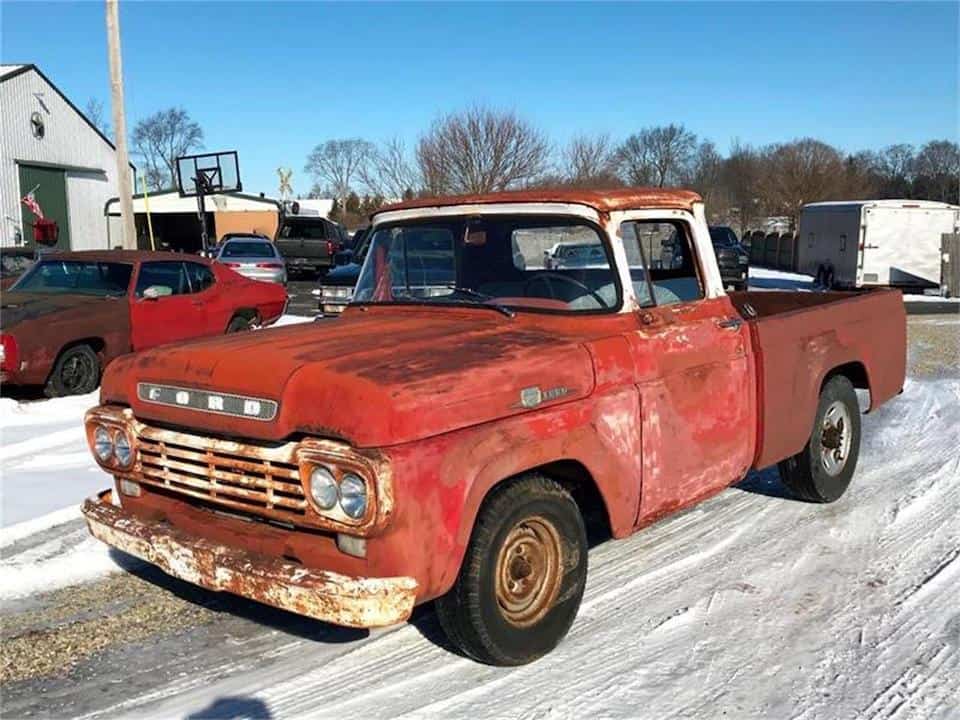
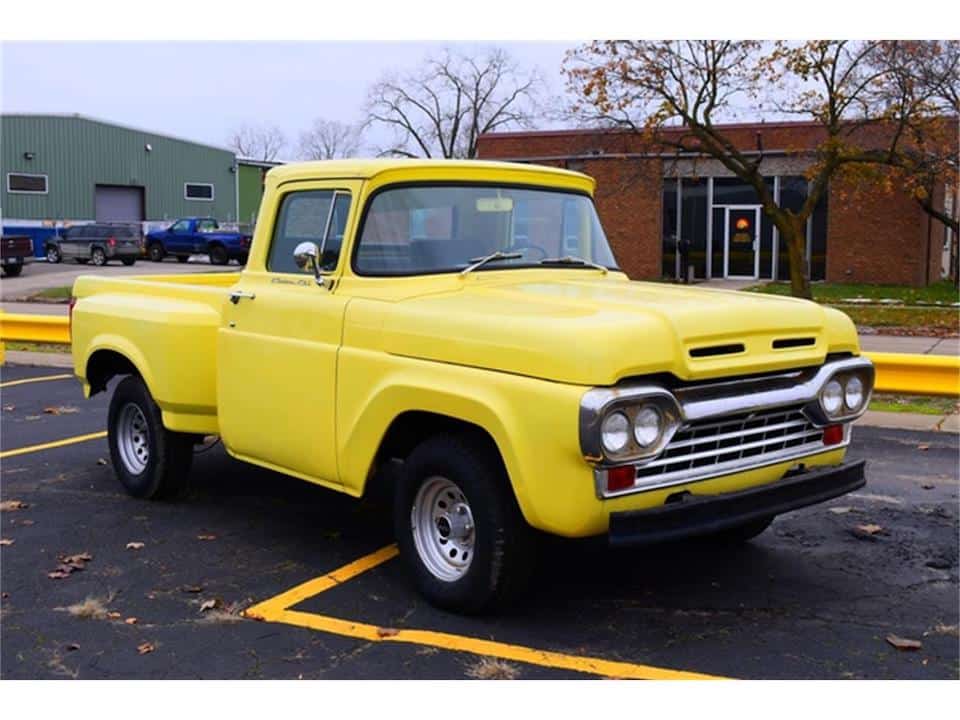
The list of colors available from the factory include:
- Prime
- Corinthian White
- Monte Carlo Red
- Goldenrod Yellow
- Caribbean Turquoise
- Holly Green
- Adriatic Green
- Skymist Blue
- Academy Blue
- Raven Black
| Engines | Years | Horsepower |
| 223 CID Milage Maker Inline 6 | 1958-1960 | 139 |
| 272 CID Y-block V8 | 1958 | 171 |
| 292 CID Y-block V8 | 1959-1960 | 193 |
| Transmissions | Automatic | Standard |
| 4 Speed Manual | ||
| 3 Speed Manual | ||
| Ford-o-matic |
4th Generation: 1961 to 1966
The fourth generation of Ford F series pickup trucks were sold from 1961 to 1966 and were wider and sleeker than the generations before. This new generation would offer several firsts to Ford’s line of light duty pickup trucks.
The first was the unibody. Originally named the integrated pickup, it consisted of the bed and cab being one continuous piece that had no gap between them. Some of the advantages of this design were the cab served as the leading side of the bed, making it less complicated and less expensive to build.
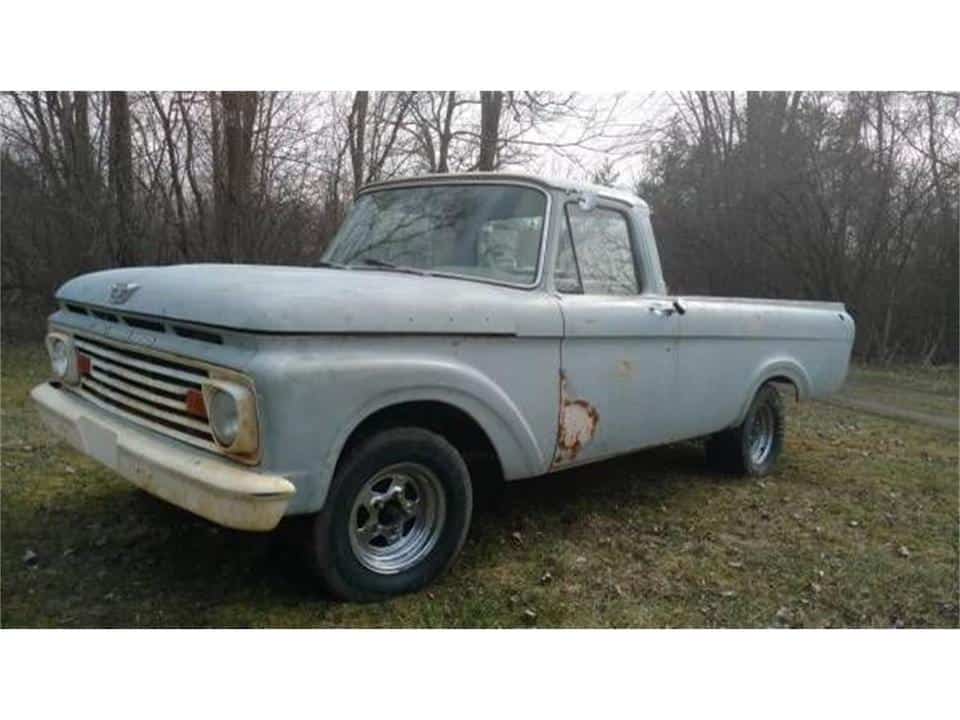
This unibody model had a poor market reception due to rumors that overloading caused the doors to jam shut. Due to these rumors and low sales the unibody was dropped from production midway through the 1963 year.
For 1965 the body remained virtually unchanged but they introduced an all new frame. The 1965 and 1966 models moved the turn signals to above the headlights.
The 300 cubic inch straight six and the 240 cubic inch straight six were introduced in 1965. The 352 cubic inch V8 was introduced also and it surpassed 200 horsepower at 208 giving the F series more than 200 horsepower for the first time.
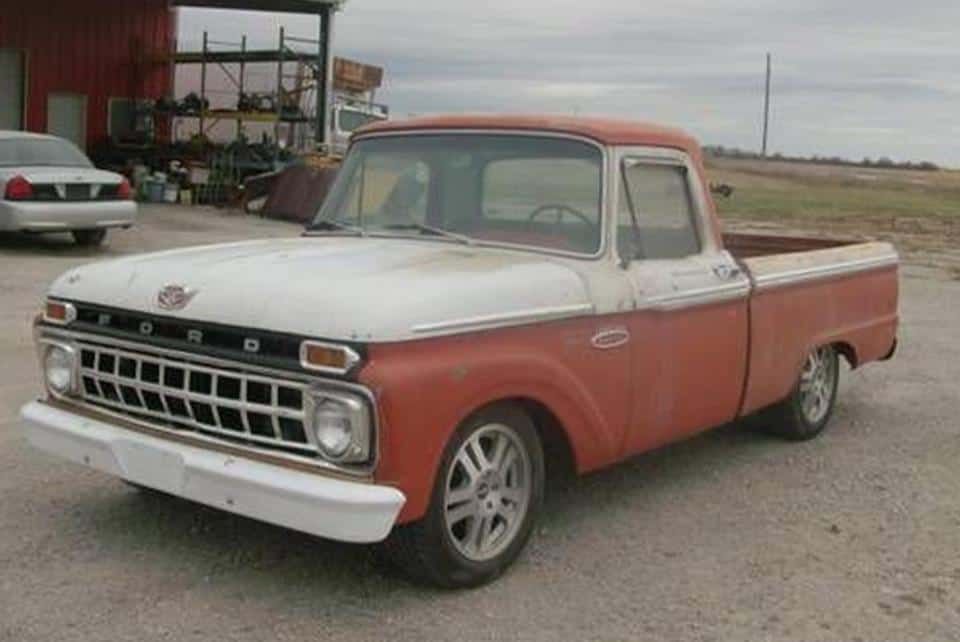
The list of paint color choices from the factory were:
- Rangoon Red
- Raven Black
- Sierra Beige
- Holly Green
- Caribbean Turquoise
- Springtime Yellow
- Arcadian Blue
- Marlin Blue
- Wimbledon White
- Pure White
- Chrome Yellow

| Engines | Years | Horsepower |
| 223 CID Mileage Maker Inline 6 | 1961-1964 | 114 |
| 262 CID Mileage Maker Inline 6 | 1961-1964 | 132 |
| 292 CID Y-block V8 | 1961-1964 | 170 |
| 240 CID Straight- 6 | 1965-1966 | 150 |
| 300 CID Straight-6 | 1965-1966 | 170 |
| 289 CID Windsor V8 (Mexican market) | 1965-1966 | 160 |
| 352 CID FE V8 | 1964-1966 | 185 |
| Transmissions | Automatic | Standard |
| Ford-o-matic | ||
| Cruise-o-matic | ||
| 3 Speed manual | ||
| 4 Speed manual |
5th Generation: 1967 to 1972
From 1967 to 1972 Ford built trucks from these model years are known as the fifth generation. This generation of trucks had sharper styling lines, and a larger cab. They also came with an expanded line of engine options.
During the production of the fifth generation F-series there were three trim levels offered, and then they were changed in 1970. The “Custom” replaced the “Base” while the “Custom Cab” became the “Sport Custom“, joining the Ranger as the different levels of trims available. Later the additional “Ranger XLT” was an upgrade from the “Ranger”.
Ford installed side marker reflectors as they were required by federal regulations for the year 1968. Ford did a redesign of the hood emblems that incorporated reflectors as well, along with the reflectors added to the rear of the bed.

In 1968 Ford added new versions of the 360 cubic inch V8 and the 390 cubic inch V8. This was also the first year of factory installed air conditioning. Dealers did the air conditioning installation before 1968.
For 1969 Ford added a new grille design along with the new 302 Windsor V8 engine option.
1970 had a mid-cycle update with quite a list of detail changes that included a completely new grille with wraparound front turn signals, exterior trim changes, and new side marker lights. The “Sport Custom” trim replaced the “Custom Cab”, and the “Ranger XLT” option was added as the top trim level.
The 1971 year received very few changes from previous years except some small trim changes. Every year during this generation Ford made changes to the grilles and so the 1971 had some minor grille changes.
Just like in the previous model years there were very little changes in the 1972 models. There was a package called the “Northland Special Package” that was offered for that year that included a bigger battery, an engine block heater, a beefed up alternator with a limited slip rear axle.
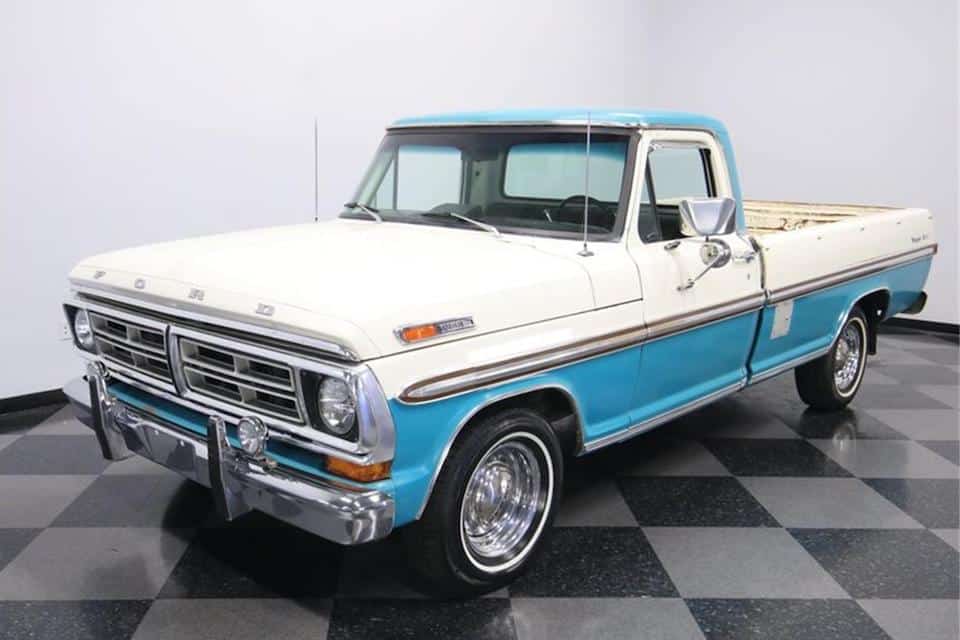
Paint choices from the factory for the 1972 year included:
- Wimbledon White
- Mallard Green
- Seapine Green Metallic
- Winter Green
- Sequoia Brown Metallic
- Calypso Coral
- Candyapple Red
- Royal Maroon
- Tampico Blue Metallic
- Prairie Yellow
- Wind Blue
- Bahama Blue
- Bay Roc Blue Metallic
- Swiss Aqua
- Chrome Yellow
- Pure White

| Engine | Years | Horsepower |
| 240 CID Inline 6 | 1967-1972 | 150 |
| 300 CID inline 6 | 1967-1972 | 170 |
| 352 CID FE V8 | 1967 | 208 |
| 360 CID FE V8 | 1968-1972 | 185 |
| 390 CID FE V8 | 1968-1972 | 215 |
| 302 CID Windsor V8 | 1969-1972 | 205 |
| Transmissions | Automatic | Standard |
| 3 Speed column | ||
| 4 Speed | ||
| 4 Speed overdrive | ||
| 3 Speed cruise-o-matic |
6th Generation: 1973 to 1979
For 1973 Ford changed to using a different sheet metal to redesign the Ford pickup, but not enough so that buyers wouldn’t recognize the truck. Sales for the truck were going up so Ford didn’t want to affect sales with a big change.
Ford moved the gas tank to under the bed for better safety and to create more storage from when it had been behind the seat in the cab. The dash now had the air conditioning vents integrated into the dash and the blower motor was put under the hood. This created more space for a larger glove box and less noise in the cab.
The 460 cubic inch V8 became available in 1974 along with the reintroduction of the 300 cubic inch straight six that had not been used for two years. The 460 V8 was not available for sale in California due to emission standards.

Ford introduced the Supercab truck in June of 1974 with a forward facing bench seat or center facing jump seats. The truck did not have any rear doors, while this option was only offered in the two wheel drive models.
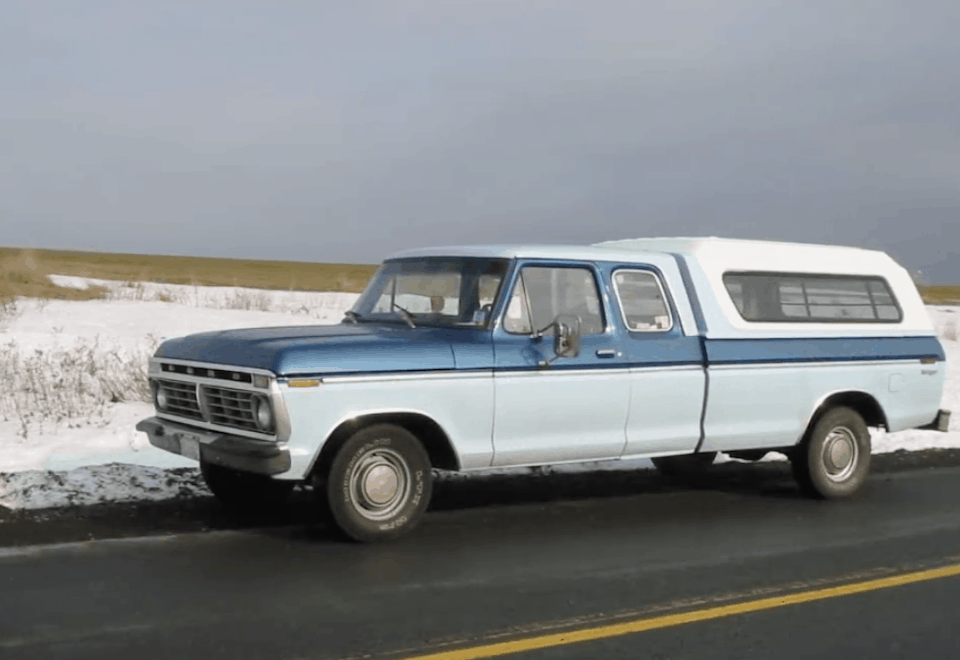
Beginning with the model year 1975 catalytic converters were standard on all F-100 trucks, and the trucks had to be run on unleaded gas. The F150 was introduced in 1974 with stronger springs and rear axles than the F-100. The F150’s were not fitted with catalytic converters and had power brakes.
After a three year absence the Flareside body was returned in 1976 and was available on two wheel drive F-100 and F-150 trucks, but on the standard cab body only.
For 1977 Ford made no body changes in the F series trucks, but updated badging, moldings and trim. You could get a rear window defogger in the options and air conditioning was available on all pickup trucks.
The 352 cubic inch V8, and the 400 cubic inch V8 2 barrel engines replaced the 360 cubic inch V8, and the 390 cubic inch V8
The 1978 F-series was a large departure from other trucks of this generation as the grille was larger with an egg crate look to it. The look included a contour bumper with rectangular headlights and signals.
Other changes brought on in 1978 included a tilt steering wheel, improved cab mounts and door seals that reduced road noise. Ford also introduced a new 4 speed manual transmission on two wheel drive pickup trucks with the 4.9L six cylinder and the 5.0 V8 engines became available.
There were very few changes made in 1979 other than minor cosmetic changes.

The factory color options for the 1979 model year included:
- Wimbledon White
- Candyapple Red
- Maroon Metallic
- Dark Blue Metallic
- Silver Metallic
- Raven Black
- Light Medium Blue
- Light Jade
- Dark Jade Metallic
- Bright Yellow
- Gold Metallic
- Medium Copper Metallic
- Light Sand
- Coral
- Medium Blue Glow
- Walnut Glow
| Engines | Years | Horsepower |
| 302 CID Windsor V8 | 1973–1976 | 135 |
| 300 CID Straight -6 | 1973-1979 | 117 |
| 302 CID Windsor V8 | 1973-1979 | 130 |
| 360 CID FE V8 | 1973-1976 | 143 |
| 390 CID FE V8 | 1973-1976 | 161 |
| 460 CID 385 V8 | 1973-1979 | 200-239 |
| 351 CID 351M V8 | 1977-1979 | 156 |
| 400 CID 400 V8 | 1977-1979 | 169 |
| Transmissions | Automatic | Standard |
| 3 Speed | ||
| Cruise-o-matic | ||
| 4 Speed |
7th Generation: 1980 to 1986 (F-100 to 1983)
The Ford F series of trucks in the 7th generation were based upon a completely new chassis and body. It had a much squarer look with flatter panels and straighter lines. This new look was designed to improve fuel economy while added to its new automatic overdrive four speed transmission as an option on the lighter F series trucks. The 3 speed C6 automatic transmission and the 4 speed manual were retained from the previous years.
These lighter F series pickups came in five configurations: SuperCab, Regular Cab, Crew Cab, with 6.5 foot long beds or 8 foot long beds. Along with the chassis and body upgrades several changes were made to the branding of this generation of F series trucks.
The F-100 was discontinued after the 1983 model year largely due to the popularity of the F-150. The F-100 nameplate did continue in Argentina.

With the introduction of the new model in 1979, drastic measures were taken to reduce weight to increase fuel economy. Large holes were cut in the frame causing weak areas with bending and buckling problems. This frame is not lovingly referred to as the “Swiss cheese frame”. This problem was remedied in 1981 for the 1982 year.
The 1980-1981 model years had a plain looking grille with “FORD” spelled in chrome lettering across the hood which was quite similar to the 1978-1979 model trucks.
There were slight cosmetic changes in the 1982 model year as they moved the letters “Ford” from above the grille and the Ford blue oval was placed in the grilles center. This was the first year the blue oval was used and has been used ever since.

The trucks became heavier in 1982 as they strengthened the frames. This would be the frame used until the 1997 model changes. There were grille options of full chrome, a black grille, and the standard plastic gray grille. You could get several different headlight bezel color options including light gray, dark gray, gray, and black.
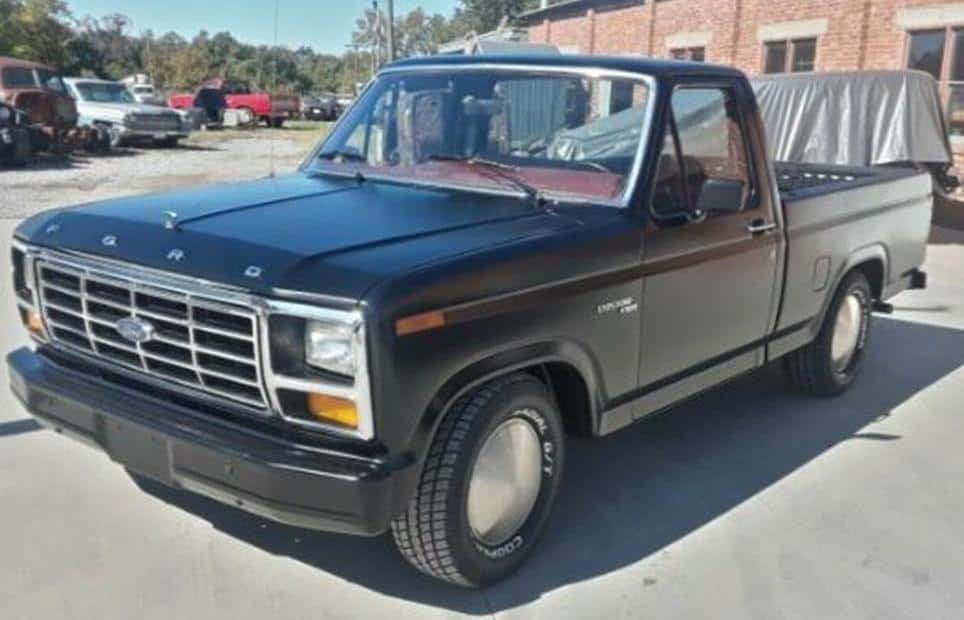
This generation of trucks had 17 different color options available, along with two-tone options and choices of clearcoat or non-clearcoat paint.
The color options from the factory for 1983 included:
- Raven Black
- Candyapple Red
- Dark Red Metallic
- Blue Glow
- Midnight Blue Metallic
- Bright Blue
- Dark Teal Metallic
- Light Teal Glow
- Copper
- Wimbledon White
- Desert Tan
- Light Desert Tan
- Light Charcoal Metallic
- Dark Charcoal Metallic
- Walnut Metallic
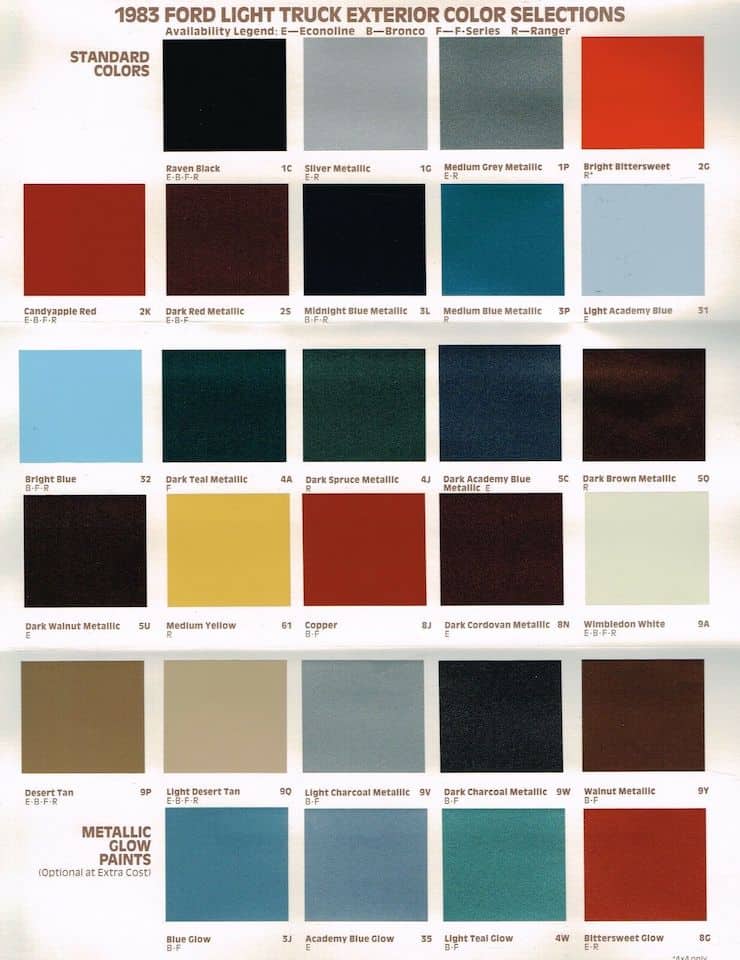
| Engines | Years | Horsepower |
| 250 cu in I6 | 1980-1985 | 131 |
| 255 cu in V8 | 1980-1981 | 115 |
| 300 cu in I6 | 1980-1986 | 120 |
| 351 cu in V8 | 1980-1985 | 150 |
| Transmissions | Automatic | Standard |
| 3-Speed Ford C6 | ||
| 4-Speed Ford AOD | ||
| 3-Speed (Column) | ||
| 4-Speed Borg-Warner T18 | ||
| 4-Speed Borg-Warner T19 |
Final Thoughts
The 50th anniversary of Ford introduced a great line up of trucks starting with the 1953 F-100. This generation of the 1953 to 1956 models is still one of the most sought after trucks by rebuilders and collectors to this day. If you can get your hands on a big window 56 you better grab it. Each generation brings its own unique body style and classic look that makes them desirable for builders and collectors of all ages. Happy Trucking!
The Tool Box
Here are some cool Ford tools:
Related Topics
What years did Dodge Motor Company build the Power wagon? The Dodge Power Wagon was a four wheel drive light truck that was produced in various model series from 1945 to 1981 by Dodge. It was also produced as a nameplate for the Dodge Ram from 2005 to 2013, and, most recently, as an individual model marketed by Ram Trucks.
What years did Studebaker build trucks? Studebaker built quality trucks continuously from 1929 to December 1963. The Champ pickup, Zip-Van postal trucks, Transtar gas jobs and medium-duty diesels were its last commercial products. Studebaker also built bus and fire engine chassis. In 1939,Studebaker introduced the low-priced, six-cylinder Champion.
You can find the black and white illustrations for sale as stickers on Ford Era’s website www.FORDERA.com and they have every year from 1948 up to 1997! Also t-shirts, hats, and other merch!
Sources: wikipedia.com
classiccars.com
Ackerson, Robert C.. Ford F100/F150 Pickup. United Kingdom, Veroce Pub., 1997.
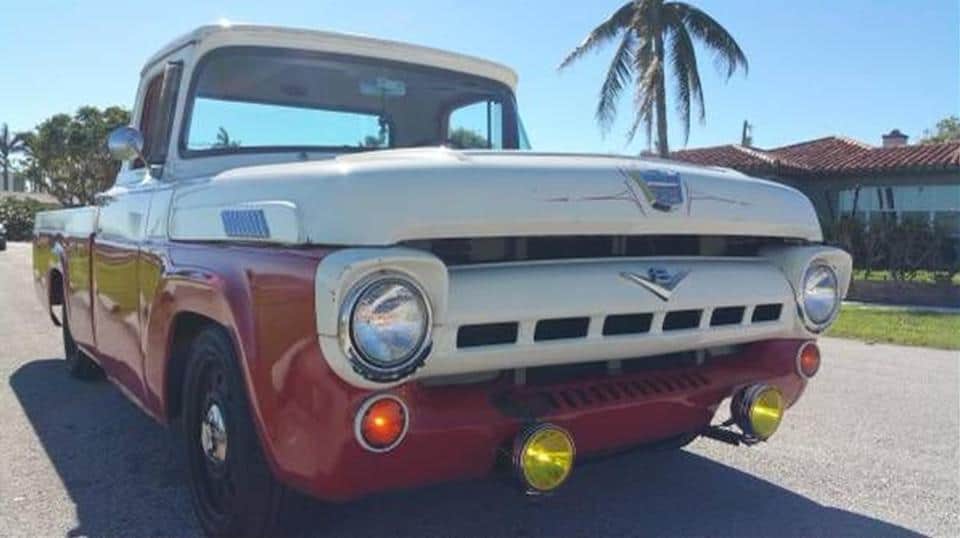







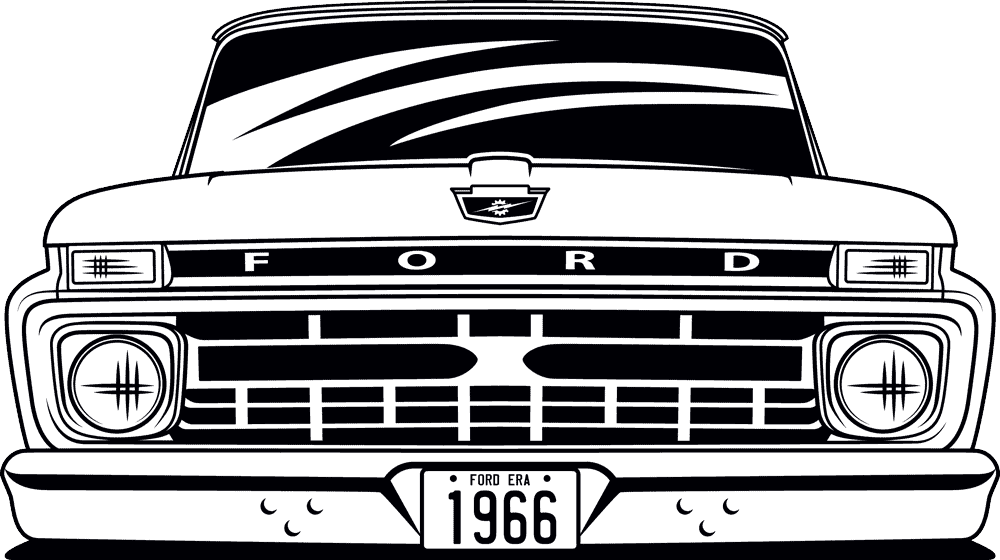
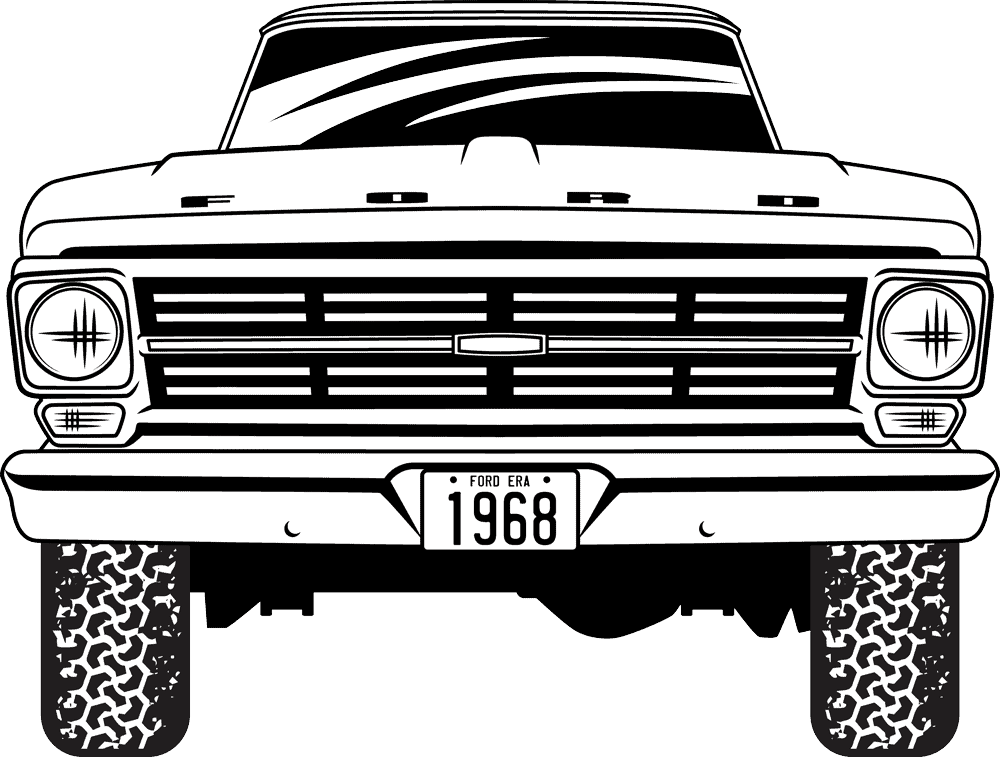
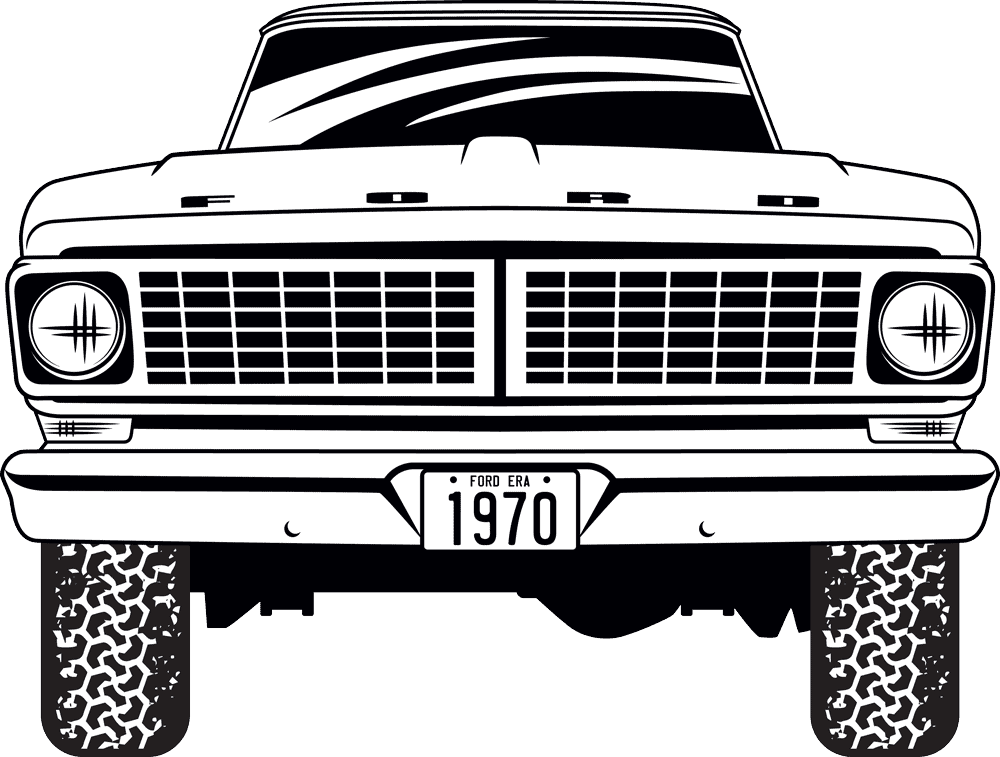
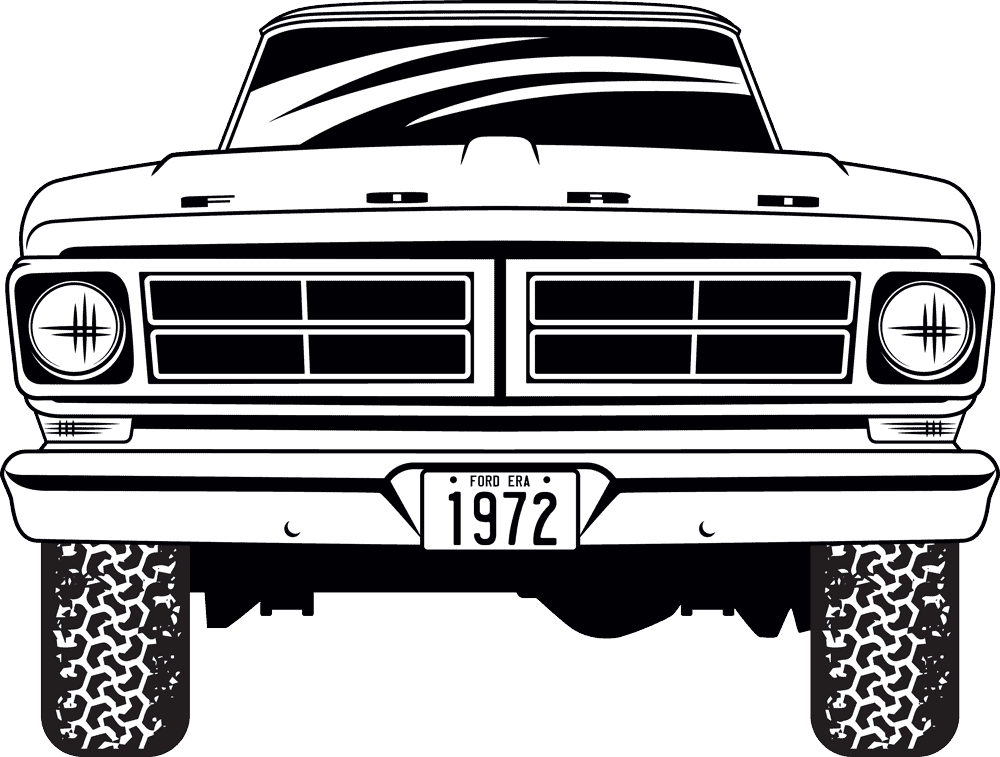
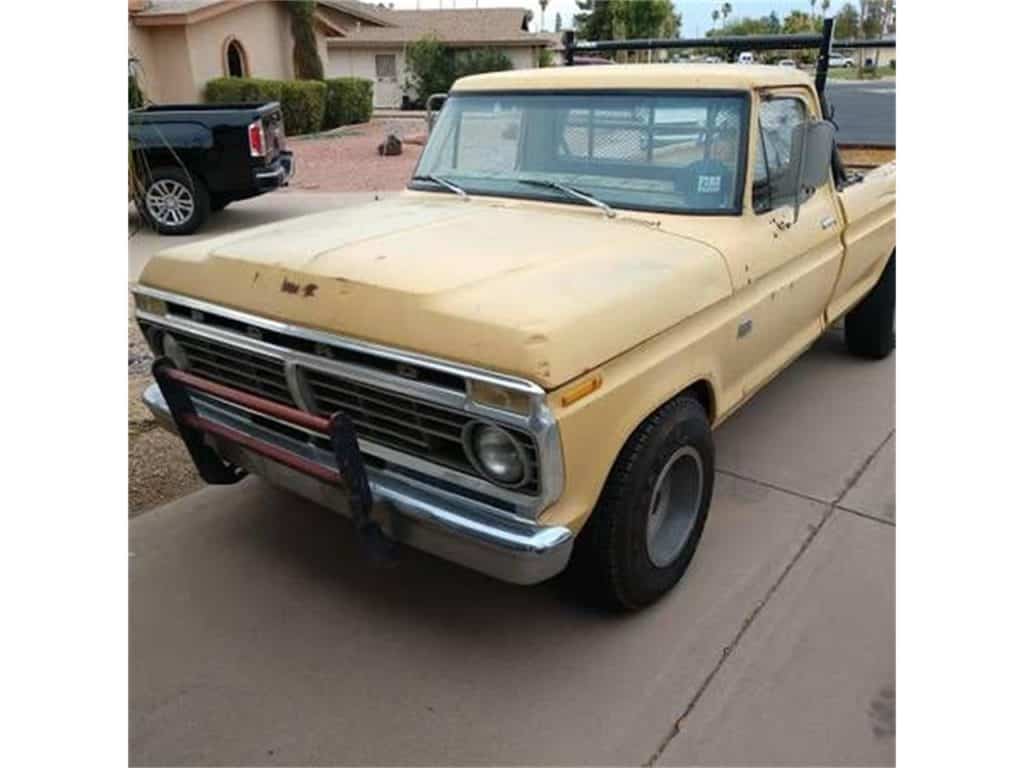
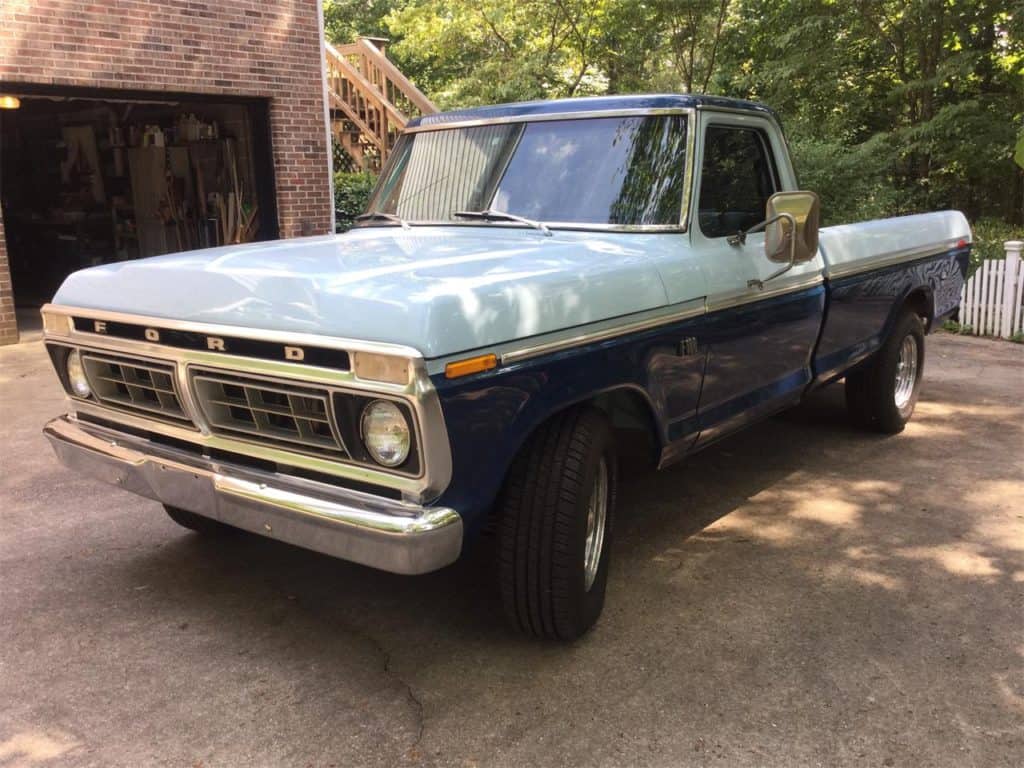
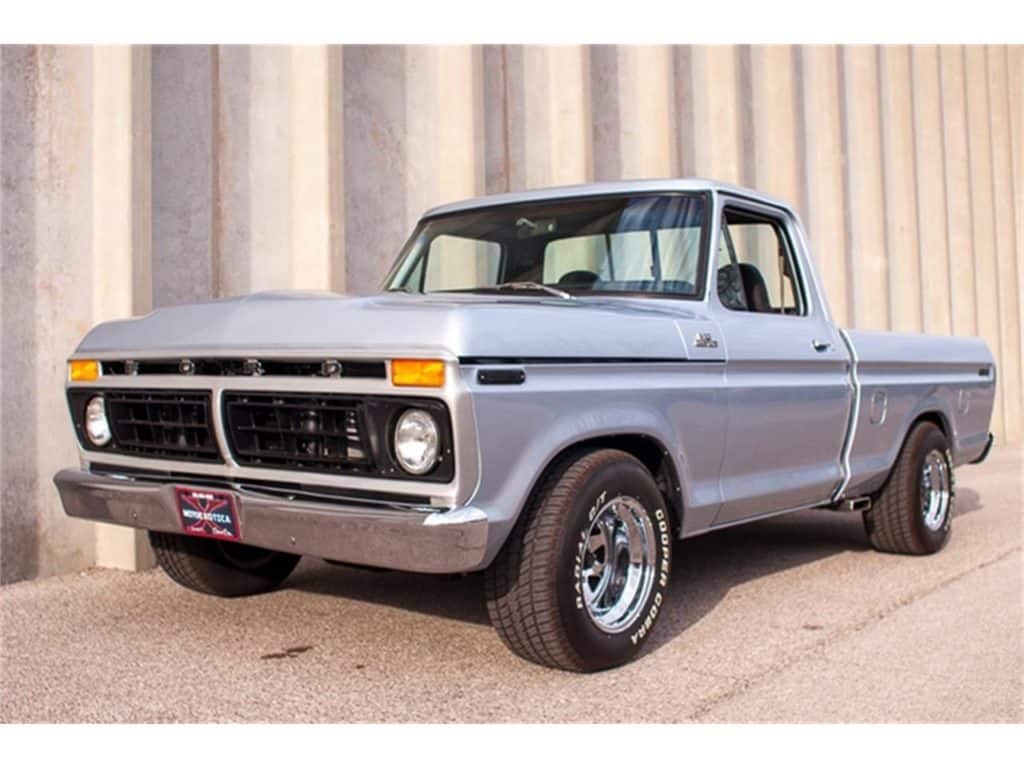
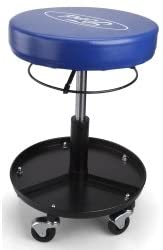
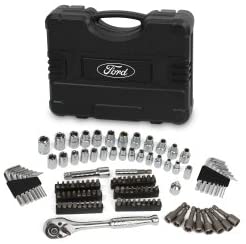
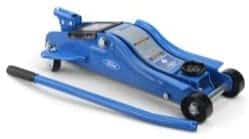

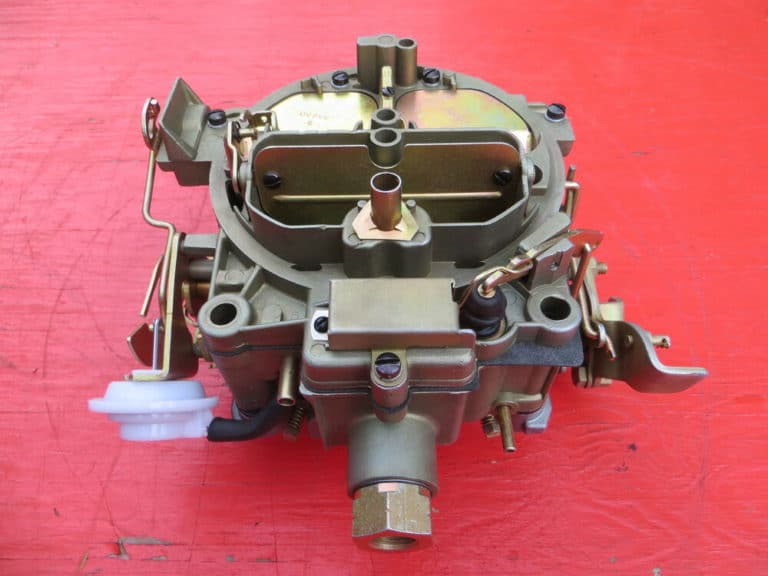
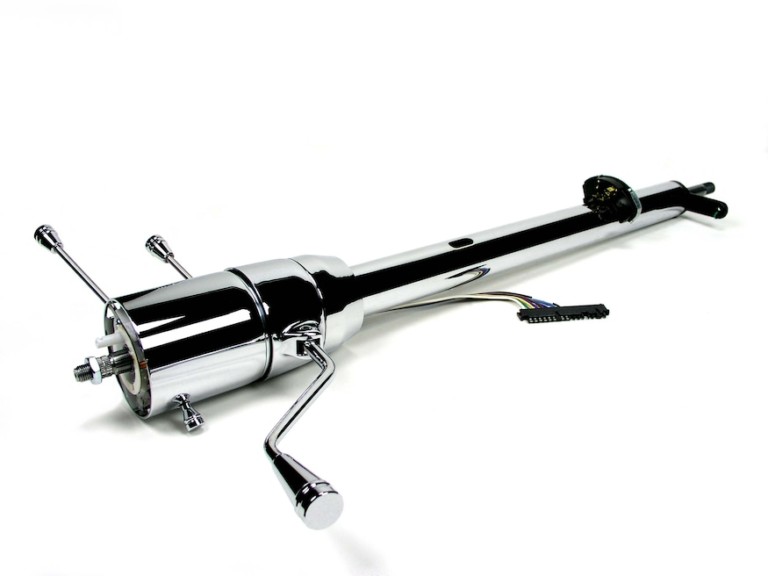
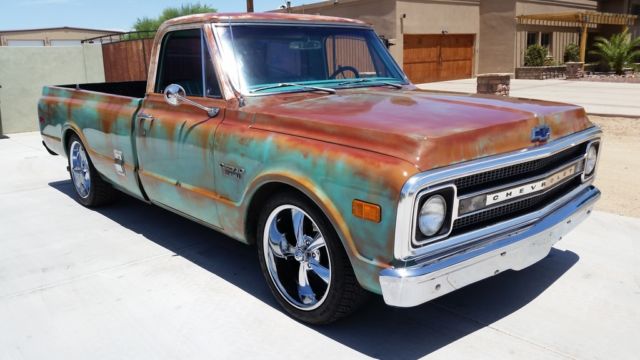
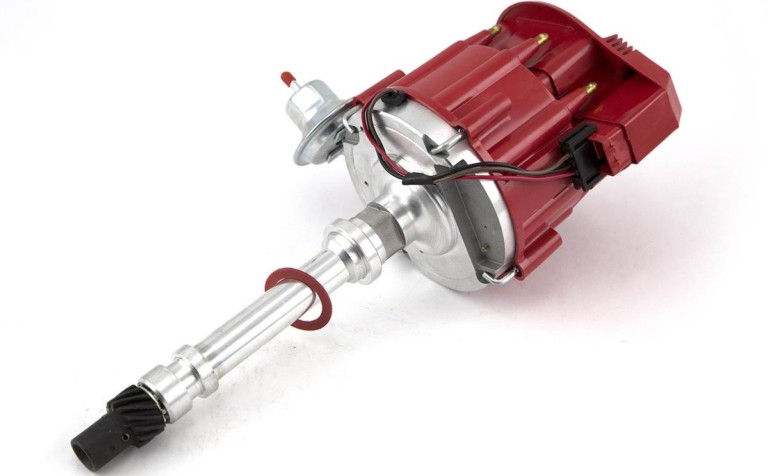

3 Comments
Comments are closed.